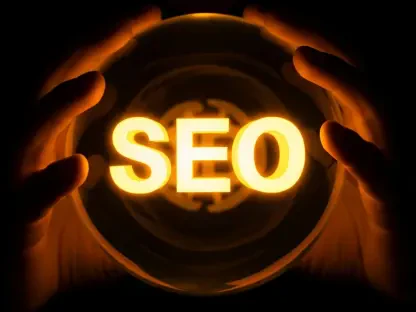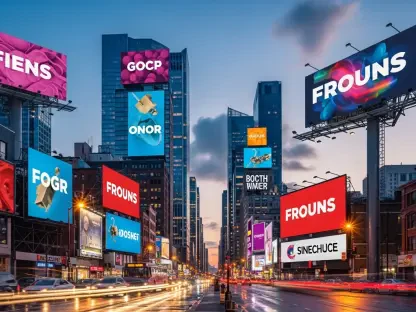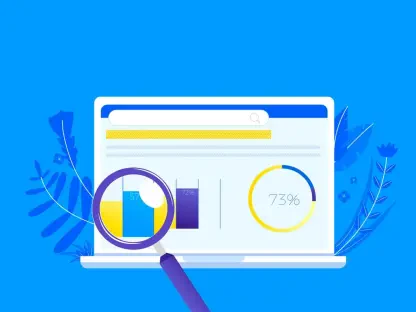Introduction
Imagine a digital advertising world where artificial intelligence not only crafts the perfect ad but also predicts consumer desires before they even click. This is no longer a distant vision but a reality shaping the industry in 2025, with Meta and Google locked in a high-stakes battle for supremacy. The global digital advertising market, valued at hundreds of billions annually, is undergoing a seismic shift driven by AI innovations. Meta, with its social media prowess, is leveraging cutting-edge tools to challenge Google’s long-standing dominance in search advertising. This report dives into whether Meta’s aggressive AI-driven growth can position it to surpass Google by 2026, exploring market dynamics, technological advancements, and the hurdles both giants face in this transformative era.
The Digital Advertising Landscape: A Battle of Giants
Current State and Industry Scope
The digital advertising sector stands as a cornerstone of the global economy, generating over $600 billion in revenue annually and influencing virtually every industry from retail to entertainment. This vast ecosystem powers brand visibility and consumer engagement on an unprecedented scale, with digital platforms dictating how businesses connect with audiences. Its significance lies not just in economic impact but also in shaping cultural trends and purchasing behaviors across borders.
At the heart of this landscape are Meta and Google, two titans commanding substantial shares of ad spend. Google has historically led with its search engine dominance, capitalizing on user intent through targeted ads, while Meta thrives on social media platforms like Facebook and Instagram, focusing on engagement and community-driven content. Their distinct approaches—search versus social—define their market positions, with Google holding a broader reach in direct conversions and Meta excelling in brand awareness.
Technological Shifts and Market Influences
Artificial intelligence has emerged as a game-changer in ad delivery, transforming how campaigns are designed and optimized. AI enables hyper-personalized ads by analyzing vast datasets to predict user preferences, automate placements, and maximize return on investment. This technological leap has reduced human intervention, allowing for real-time adjustments that enhance ad effectiveness across platforms.
Consumer behavior is also evolving, with users demanding more relevant and less intrusive advertising experiences. The shift toward data-driven strategies has become critical, as advertisers rely on insights from browsing habits and social interactions to tailor their messaging. This trend underscores the growing importance of AI in interpreting complex patterns and delivering value to both businesses and consumers.
Beyond personalization, the influence of mobile usage and short-form content has reshaped market priorities. Platforms are now compelled to adapt to fleeting attention spans, pushing AI to refine algorithms for quicker, more impactful impressions. This dynamic environment sets the stage for intense competition between Meta and Google as they harness these shifts to gain an edge.
AI Innovation: Meta and Google’s Competing Strategies
Meta’s AI-Driven Growth
Meta has positioned itself at the forefront of AI innovation with tools like Advantage+ Sales Campaigns, which have delivered a remarkable 22% increase in return on ad spend for advertisers. This automation-focused solution simplifies campaign management, enabling businesses to reach targeted audiences with minimal effort. The impact is evident in enhanced performance metrics that continue to attract a diverse range of clients.
Another significant development is the Andromeda platform, a machine learning system that has boosted ad conversions by 5% on Instagram and 3% on Facebook, while also driving a 5-6% rise in user engagement. These figures highlight Meta’s ability to refine ad relevance and pricing, with average ad costs rising by 9% due to improved targeting precision. Such advancements underscore a strategic focus on maximizing user interaction.
Meta’s strength lies in leveraging social media for brand awareness, where emotional connections and viral content often outweigh direct sales pitches. By prioritizing engagement over immediate conversions, the company taps into long-term loyalty, a tactic that resonates with advertisers aiming to build lasting relationships with their audience. This approach is proving to be a potent driver of growth in a crowded market.
Google’s AI-Powered Defense
Google, in contrast, maintains its stronghold through AI integrations tailored for search environments, such as AI Mode, which embeds ads seamlessly within results. The Gemini-powered AI Overviews further enhance user experience by summarizing content while subtly incorporating promotional material. These tools ensure that ads remain relevant to users actively seeking information or products.
Additionally, AI Max for Search automates campaign optimization, allowing advertisers to scale efforts with precision and efficiency. This focus on high-intent conversions—where users are closer to making purchases—solidifies Google’s position as the go-to platform for immediate results. The integration across search and YouTube amplifies its reach, capturing diverse user behaviors under one ecosystem.
Google’s strategy hinges on maintaining dominance in environments where decision-making is direct and measurable. By prioritizing search and video content through YouTube, the company addresses both informational and entertainment needs, ensuring advertisers see tangible outcomes. This dual focus creates a robust defense against emerging competitors like Meta.
Market Share Dynamics and Revenue Trends
Meta’s Explosive Revenue Growth
Meta’s financial trajectory in digital advertising is nothing short of staggering, with ad revenue reaching $160.6 billion in the latest reported year, accounting for 97% of its total earnings. A notable 21% year-over-year increase brought its Q2 revenue to $46.6 billion, reflecting robust demand for its AI-enhanced ad solutions. These numbers signal a company rapidly closing gaps with industry leaders.
In terms of market dynamics, Meta captures 45 cents of every incremental ad dollar spent, outpacing Google’s 30 cents, a trend that illustrates its growing appeal among advertisers. Its U.S. market share stands at 21.3%, surpassing YouTube’s individual contribution, which points to a shift in preference for social media-driven campaigns over isolated video platforms. This momentum is a critical indicator of potential future dominance.
The growth is fueled by Meta’s ability to attract diverse advertisers, from small businesses to global brands, through accessible AI tools. By lowering entry barriers and offering measurable engagement boosts, the company is redefining how ad budgets are allocated. This adaptability positions Meta as a formidable contender in reshaping industry standards.
Google’s Sustained Lead and Challenges
Google continues to lead the pack with a commanding $54.2 billion in ad revenue for Q2 and a historical benchmark of over $237 billion annually in prior years. Holding a 45% share of global digital ad spend, its dominance in search advertising remains unchallenged for now, driven by unparalleled scale and user trust in its ecosystem. This entrenched position is a significant barrier for any rival.
However, vulnerabilities are emerging as Meta gains traction in brand-focused advertising spaces. Google’s reliance on search, while lucrative, faces pressure from shifting advertiser priorities toward engagement over direct clicks in certain sectors. Balancing innovation in AI with maintaining core strengths is becoming a complex challenge for the tech giant.
The competition for incremental ad dollars also reveals cracks in Google’s armor, as Meta’s aggressive growth captures market attention. While still ahead, the narrowing gap suggests that complacency is not an option. Google must address these challenges to sustain its lead over the coming years, especially as AI reshapes advertiser expectations.
Challenges in the AI Advertising Race
The race to dominate AI-driven advertising is not without obstacles, with user trust standing as a primary concern. As personalization deepens, consumers grow wary of how their data is used, creating a delicate balance for Meta and Google to maintain transparency while pushing technological boundaries. Mishandling this could erode confidence and impact ad effectiveness.
Data privacy concerns compound these issues, with both companies facing scrutiny over collection practices. The complexity of scaling AI tools to meet diverse advertiser needs—ranging from niche startups to multinational corporations—adds another layer of difficulty. Ensuring consistent quality across varied campaigns remains a persistent hurdle in this fast-evolving space.
Moreover, competitive pressure heightens the risk of over-reliance on automation, potentially at the expense of ad relevance or creativity. If AI systems prioritize efficiency over nuanced messaging, the result could be generic content that fails to resonate with audiences. Navigating this tightrope between innovation and quality is crucial for sustained success in the industry.
Regulatory Landscape and Its Impact
Data privacy regulations are tightening globally, posing significant challenges to AI-driven advertising models employed by Meta and Google. Laws such as the General Data Protection Regulation in Europe and various state-level policies in the U.S. demand stricter compliance, limiting how personal information can be leveraged for ad targeting. These rules reshape operational frameworks for both companies.
Compliance is not merely a legal obligation but a financial risk, with potential fines reaching billions for violations. Both giants must invest heavily in systems that adhere to evolving standards while still delivering effective ad solutions. This balancing act between regulatory adherence and innovation is a defining issue for the sector’s future.
Beyond fines, the broader impact lies in fostering ethical advertising practices without stifling progress. Striking this equilibrium requires proactive engagement with policymakers and transparent communication with users. How Meta and Google navigate this landscape will influence not just their operations but also public perception of digital advertising as a whole.
Future Outlook: Can Meta Surpass Google by 2026?
Looking ahead, Meta’s growth trajectory appears promising with innovations like Creative Sticker CTA for Instagram Reels and Video Generation 2.0 for dynamic ads. These tools aim to simplify content creation for advertisers, especially small businesses, while its automation roadmap targets full campaign management by 2026. Such advancements could significantly bolster its competitive stance.
Google, however, retains formidable strengths in high-intent search environments, where users are primed for conversions. Counter-strategies may involve deeper AI integration across commerce and localized advertising to maintain its edge. Its vast data resources and established advertiser base provide a solid foundation to weather Meta’s challenge over the next few years.
The global AI advertising market is projected to grow at a 28.4% compound annual growth rate through 2033, intensifying the rivalry between these tech giants. This expansion will likely fuel further innovation, with both companies vying to capture emerging opportunities in untapped regions and demographics. The outcome by 2026 hinges on execution and adaptability in this dynamic landscape.
Conclusion
Reflecting on the intense competition between Meta and Google, it becomes clear that AI has redefined the digital advertising arena with unprecedented speed. Meta’s remarkable strides in automation and engagement-driven platforms have positioned it as a serious contender, while Google’s entrenched dominance in search and conversions holds firm. The battle has revealed not just technological prowess but also the complexities of user trust and regulatory navigation.
Moving forward, both companies need to prioritize sustainable innovation by investing in transparent data practices and user-centric ad experiences. Advertisers and investors alike must monitor how each adapts to privacy laws and scales AI tools without sacrificing relevance. A critical next step is fostering industry-wide collaboration to set ethical standards, ensuring that the pursuit of market share does not undermine consumer confidence.
As the landscape continues to evolve, the focus shifts to anticipating consumer trends and leveraging AI for meaningful connections rather than mere transactions. The years ahead promise to test the resilience of Meta’s momentum against Google’s legacy, with outcomes that will shape digital marketing for decades. Staying agile and responsive to these shifts remains essential for all stakeholders in this transformative journey.









